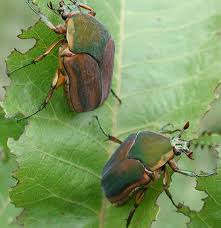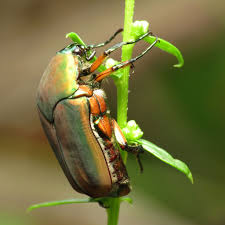Although green June bugs prefer to feed on decaying organic matter, they are not safe for your

Green June Beetles
produce and for your turf. While tunneling in and out, they can loosen the soil severely, making it unfit for turf and other agricultural plants. The grubs may eat underground produce such as sweet potatoes and carrots. The larvae also feed on the roots of plants. You must, therefore, get rid of them as soon as you notice their presence, preferably, in the summer, when they are in their first larval stage. Once they enter their third larval stage, they will dig deeper into the soil to overwinter and then, they will come out as fully grown adults in the next summer.
Here are some useful tips on how to control green June bugs organically
- June beetles are delicious meals for a Scolia Dubia, a type of digger wasp. These wasps are most active during early fall and this is the right time to get rid of the tiny little insects that can affect your produce. Till your soil during the fall and in early spring and let the wasps feed on their meal. Scolia dubia, also known as blue-winged wasp, flies just above the turf, looking for grubs and, by tilling, you will make it easier for them to find their food. To encourage their movement in your garden or agricultural land, avoid the use of broad-spectrum pesticides.
- Other than Scolia Dubia, snakes, frogs, toads, and songbirds also love to feast upon June beetles. Snakes can be risky but you can try frogs and toads. In fact, having toads in your agricultural land is considered to be one of the best ways of controlling green June bugs. Toads are also nocturnal like grubs and they will help you hunt down these pests.
- If you don’t want to rely on natural predators, you can try the nematode method. Nematodes are microscopic organisms. Many of them are parasites of insects, plants, and animals including human beings. Two species of nematodes Steinernema spp. and Heterorhabditis spp. are insect parasites and they are helpful for controlling green June bugs. You can buy these nematodes from your nearby gardening store. All you have to do is to mix a certain quantity of nematode mixture with water and spray it on the affected area. Not every nematode mixture will work on June bugs. Make sure you buy the right variety and follow the packaging instructions accurately. These parasites have a very short shelf-life and therefore, you shouldn’t store the mixture for long.
- Like nematodes, milky spore is also a form of microorganism that can help you control green June bugs. It should be available at your local gardening store. You need to sprinkle it in your lawn or agricultural land just like you sprinkle grass seeds and then water the soil for 15-20 minutes. It will take at least 7-15 days to see the effect of these bacteria. Milky spore doesn’t harm earthworms, plants, pets, most insects, and human beings and therefore, it is safe to use.
Here are some useful tips on how to control green June bugs chemically
Natural methods are often enough to control green June beetles, but if you are not finding them effective enough, you may go for chemical treatment. Your local gardening store can help you

A green June bug strutting its stuff
choose a relevant insecticide that will kill the grubs, keeping other insects and plants safe. The insecticides have to be applied in the fall, when the June bugs are in their first larval stage. Once the grubs mature, you will not be able to do much, except wait for them to lay eggs.
If you want to use chemicals, please keep in mind that the insects will die on the surface of the soil, leaving dead, smelly grubs on it. You may have to remove the dead grubs to get rid of the smell.
Preventive measures for green June bugs
- A healthy lawn rarely becomes the breeding site for bugs. So, try to keep your grass as healthy as possible. Do not let organic matters rot in the soil. Also, make sure your land has a good irrigation and drainage system.
- Green June bugs prefer to lay their eggs in short grass. If you mow your lawn high in summer, you will be able to discourage these pests from laying eggs in your land.
The presence of green June bugs is not always bad for your lawn. When present in moderate numbers, they help aerate the soil but if they are present in large numbers, they may damage the turf, plants, and even the produce. Therefore, do not use chemicals to treat your lawn or agriculture land on your own. Instead, contact your nearby pest control to find out if the treatment is required at all.

No Comments